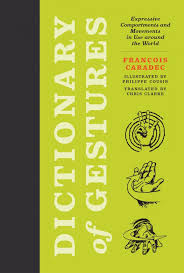Thea Lenarduzzi at the TLS:
 Caradec’s Dictionary, newly translated into English by Chris Clarke, lists some 850 gestures that “successively address each part of the body, from top to bottom, from scalp to toe by way of the upper limbs”, and may be used as well as or instead of speech. They are numbered and ordered in a taxonomy running from 1.01 (“to nod one’s head vertically up and down, back to front, one or several times: acquiescence”) to 37.12 (“to kick an adversary in the rear end: aggression”), and accompanied by Philippe Cousin’s illustrations. The majority of them are what the psychologist David McNeill has called “imagistic”, by which parts of the body are arranged to figure an imagined object or action (such as blowing a kiss, or proffering one’s middle finger), and are “effected voluntarily by humankind in order to communicate with each other”. The emphasis designates this type of non-verbal expression – Adam Kendon calls it “visible action as utterance” in his seminal Gesture (2004) – as a sub-category of body language more broadly, which comprises both conscious (that is, learnt) and unconscious (instinctive) movements.
Caradec’s Dictionary, newly translated into English by Chris Clarke, lists some 850 gestures that “successively address each part of the body, from top to bottom, from scalp to toe by way of the upper limbs”, and may be used as well as or instead of speech. They are numbered and ordered in a taxonomy running from 1.01 (“to nod one’s head vertically up and down, back to front, one or several times: acquiescence”) to 37.12 (“to kick an adversary in the rear end: aggression”), and accompanied by Philippe Cousin’s illustrations. The majority of them are what the psychologist David McNeill has called “imagistic”, by which parts of the body are arranged to figure an imagined object or action (such as blowing a kiss, or proffering one’s middle finger), and are “effected voluntarily by humankind in order to communicate with each other”. The emphasis designates this type of non-verbal expression – Adam Kendon calls it “visible action as utterance” in his seminal Gesture (2004) – as a sub-category of body language more broadly, which comprises both conscious (that is, learnt) and unconscious (instinctive) movements.
more here.
